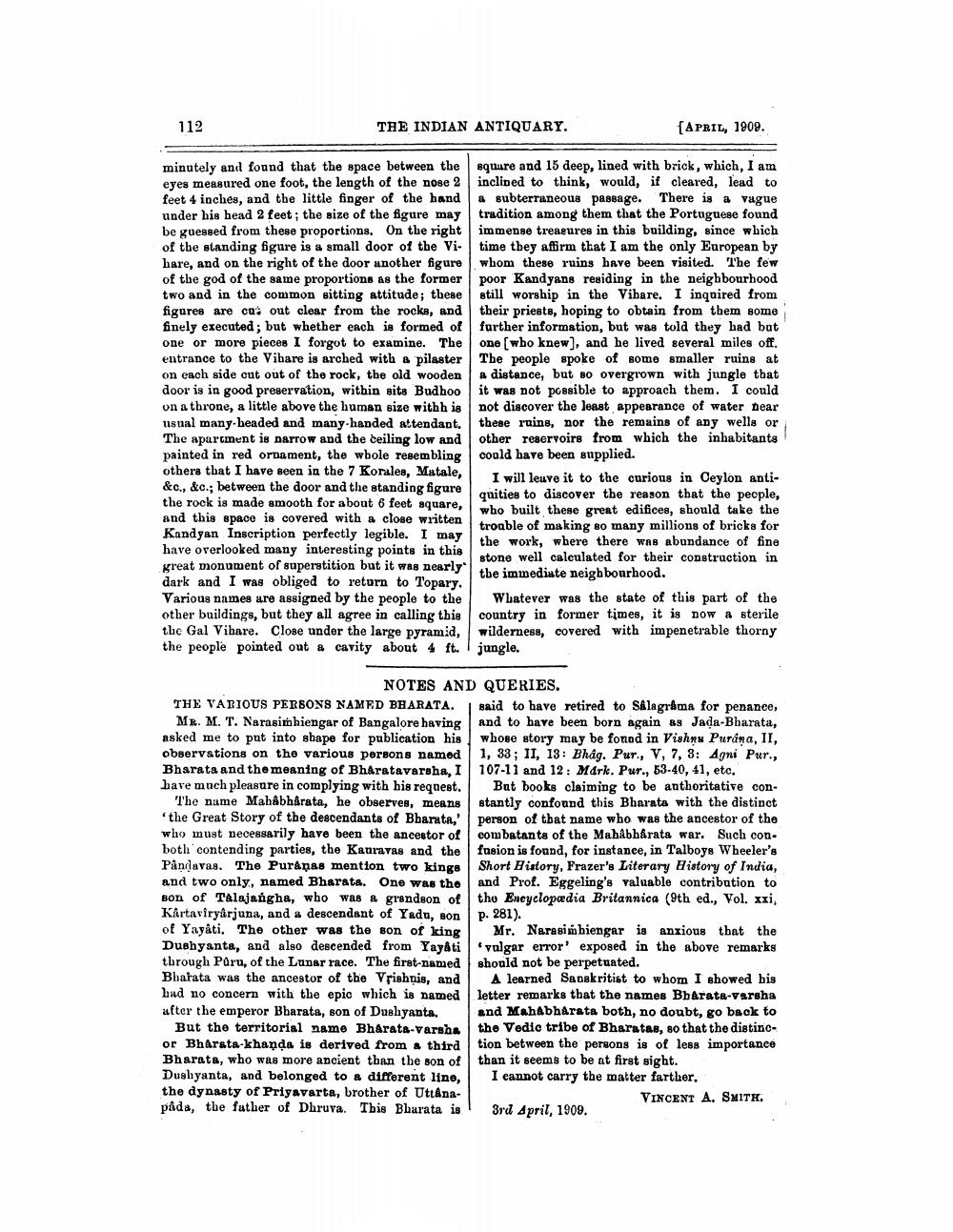________________
112
THE INDIAN ANTIQUARY.
[APRIL, 1909.
minutely and found that the space between the eyes measured one foot, the length of the nose 2 feet 4 inches, and the little finger of the hand under his head 2 feet; the size of the figure may be guessed from these proportions. On the right of the standing figure is a small door of the Vi- hare, and on the right of the door another figure of the god of the same proportions as the former two and in the common sitting attitude; these figures are ca: out clear from the rocka, and finely executed; but whether each is formed of one or more pieces I forgot to examine. The entrance to the Vibare is arched with a pilaster on each side cut out of the rock, the old wooden door is in good preservation, within sits Budhoo on a throne, a little above the human size withh is usual many beaded and many-handed attendant.
The apartment is narrow and the ceiling low and painted in red ornament, the wbole resembling others that I have seen in the 7 Korales, Matale, &c., &c.; between the door and the standing figure the rock is made smooth for about 6 feet square, and this space is covered with a close written Kandyan Inscription perfectly legible. I may have overlooked many interesting points in this great monument of superstition but it was nearly dark and I was obliged to return to Topary. Various names are assigned by the people to the other buildings, but they all agree in calling this the Gal Vihare. Close under the large pyramid, the people pointed out a cavity about 4 ft.
squure and 15 deep, lined with brick, which, I am inclined to think, would, if cleared, lead to a subterraneous passage. There is a vague tradition among them that the Portuguese found immense treasures in this building, since which time tbey affirm that I am the only European by whom these ruins have been visited. The few poor Kandyans residing in the neighbourhood still worship in the Vihare. I inquired from their priests, hoping to obtain from them some further information, but was told they had but one who knew], and he lived several miles off. The people spoke of some smaller ruins at a distance, but so overgrown with jungle that it was not possible to approach them. I could not discover the least appearance of water bear these ruins, nor the remains of any wells or other reservoirs from which the inhabitants could have been supplied.
I will leuve it to the curious in Ceylon antiquities to discover tbe reason that the people, who built these great edifices, should take the trouble of making so many millions of bricks for the work, where there was abundance of fine stone well calculated for their construction in the immediate neighbourhood.
Whatever was the state of this part of the country in former times, it is now a sterile wilderness, covered with impenetrable thorny jungle.
NOTES AND QUERIES. THE VARIOUS PERSONS NAMED BHARATA. said to have retired to S&lagrama for penance,
MR. M. T. Narasimhiengar of Bangalore having and to bave been born again as Jada-Bharata, asked me to put into sbape for publication his whose story may be fonod in Vishnu Purana, II, observations on the various persons named 1, 33; II, 13: Bhag. Pur., V, 7, 3: Agni Pur., Bharata and the meaning of Bharatavarsha, I 107-11 and 12: Mark. Pur., 53-40, 41, etc. have much pleasure in complying with his request. Bat books claiming to be authoritative con
The name Mahabharata, he observes, means stantly confound this Bharata with the distinct the Great Story of the descendants of Bharata,' | person of that name who was the ancestor of the who must necessarily have been the ancestor of combatants of the Mahabharata war. Such conboth contending parties, the Kauravas and the fusion is found, for instance, in Talboys Wheeler's Påndavas. The Puranas mention two kings Short History, Frazer's Literary History of India, and two only, named Bharata. One was the and Prof. Eggeling's valuable contribution to son of Talajangha, who was a grandson of the Encyclopædia Britannica (9th ed., Vol. xxi, Kartaviryarjuna, and a descendant of Yadu, son p. 281). of Yayati. The other was the son of king Mr. Narasis biengar is anxious that the Dushyanta, and also descended from Yayâtivulgar error' exposed in the above remarks through Paru, of the Lunar race. The first-named should not be perpetuated. Bharata was the ancestor of the Vrishộis, and A learned Sanskritist to whom I showed his had no concern with the epic which is named letter remarks that the names Bharata-vareha after the emperor Bharata, son of Dushyanta. and Mahabharata both, no doubt, go back to
But the territorial name Bharata varsha the Vedic tribe of Bharatas, so that the distincor Bharata-khanda is derived from a third tion between the persons is of less importance Bharata, who was more ancient than the son of than it seems to be at first sight. Dushyanta, and belonged to a different line, I cannot carry the matter farther. the dynasty of Priyavarta, brother of Uttana
VINCENT A. SMITH. pada, the father of Dhruva. This Blurata is 3rd April, 1909.




